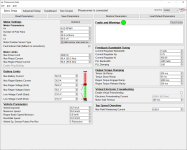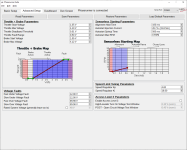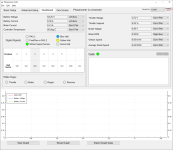psytrout42
1 µW
- Joined
- Jul 11, 2021
- Messages
- 3
Hello Folks,
This is more of an open discussion rather than a specific troubleshooting topic. I'm looking for others than have had experience with multiple generations of Grin ASI-based controllers to see if anyone else has noticed a change in the newest generation.
Backing up a bit for context. I had been running a Phaserunner V3 for a couple years, initially on a 9C clone and then on a 10T GMAC. This system is running on a 52v EM3EV battery and was rock-solid reliable in all conditions and situations. I had the system typically configured draw a max of 30A from the battery, and had the CA set to limit power to "1500w" and it would get up to those numbers when asked.
I was exceedingly happy with the system, so much so that I ponied up the bucks to outfit my wife's Cattrike 5.5.9 with a PR/GMAC combo. At that time the Baserunner V5 L10's had come out and I was going to be building the battery, so I grabbed a couple Reention DP-6C cases and controllers so this and another project would look clean and neat. Once all the components were in I eagerly got to building, and upon completion was..... immediately disappointed.
My wife had an accident 15 years ago that smashed her lower leg, and it's now full of metal parts. While being part cyborg can be interesting, it also means she cannot use that leg for any usable human power, which is why a torque'y motor is critical. She needs power off the line to make this whole thing work, and while my GMAC on the Phaserunner V3 set to 30A and 1500W had more than enough umph to smoothly launch me up to speed this system also set to 30A and 1500W did not. I know the PR and BR-L10's have different phase current limits (96 vs. 70), but this system was putting out less off the line torque than an old Baserunner Z9. It would pulse, buck, and grind from a standstill, slowly start moving, and once up to speed would then have all sorts of torque.
It acted as if it was in sensorless mode, but that was certainly not the case. Putting the system in sensorless mode would produce a very different pulsing, but which was perfectly normal for a sensorless start in my experience. If she had to start on an uphill incline, the system would often buck for a couple seconds and then go into an error state and not produce power until turned off and back on. By contrast my daughter's bike running a Baserunner Z9 on a G311 has far more pulling power off the line running with far less phase amps and at 12A/500w is silky smooth like my Phaserunner V3. No amount of autotuning or tweaking ramping would correct this problem, and as much as I love Grin and their products their support staff often don't respond, and the one time they did to a detailed email it looked like a cut and paste from a script to check if connections were good, which I had already laid out in the email.
Fast forward to this March when I made a boneheaded move and downloaded Phaserunner Suite 1.8.0 and the most recent controller defaults and decided to apply those to my Phaserunner V3. Immediately after that I started getting a couple problems.
First the bike would go into regen speed limiting when the wheel hit 4MPH, while the CA was set to have that kick in at 25. This was mostly corrected by setting the 'Wheel Sp. Sensor Pulses Per Rev' setting (which appears to be new in 1.8.0) to 0 Pulses/Rev where it defaulted to 6.
I was prompted to do this when I noticed in the Phaserunner Suite dashboard that it thought the bike was going 200km/h when the tire was barely spinning. I also started getting the instantaneous phase over-current (error 2.2) events when putting load on the system. Nothing physical changed on the bike or in the system, just loading these new defaults with version 1.8.0.
Now working in tech I should know better than to apply updates without a 'full' backup, and I did not in this case so that V3 is now stuck this way and virtually unusable. Running an autotune after the update would occasionally result in a bad hall pattern detected error during the spin test, prompting me to swap out this GMAC core for a spare I had with the same result. Halls all tested good, phase wires all test good, I was stumped.
I (reluctantly) ended up ordering a new Phaserunner V6 in April to just get this system back to being reliable as I need it for my work. Once that came in and I got it installed and ran into the same problem with my wife's Baserunner-L10 V5, weak on starting, not at all smooth. Loading the motor defaults for the GMAC would cause the instantaneous phase over-current with any load on the wheel, and the autotune would come back with very different Rs and Ls values than what the V3 detected. Putting in the alternate motor core (and subsequently a diffrernt cable) would result in the same thing.
This V6 also will not power the GMAC to the levels I was getting with the V3. When the autotune function is run multiple times it eventually result in settings that would allow the controller to power the motor without the phase overcurrent error, but it also lowers the Nm from 105.2 (GMAC defaults) to 104.2 or occasionally lower which didn't happen on the V3. In use on the road I'm not getting the same acceleration or torque I did with the V3, and the regen went from a strong 500W+ of stopping power to maxing out around 250W. Setting the controller to draw a max of 40A from the battery for testing and setting the CA limit to 2000W would only get me a max of 1440W at full throttle under load where the V3 would actually produce that when it was functional. Nothing I could do would result in this system producing the same power and feel the V3 did.
This last weekend I opted to convert our old RadWagon to a CA3 and the other Baserunner-L10 V5, and its also exhibiting the same behavior as the Cattrike and this Phaserunner V6. Off the line it's incredibly weak and pulsing the Bafang like a jackhammer until it gets some speed. Absolutely no chance of getting it moving on an uphill incline with a child on the back without putting in a couple hundred watts of leg power to get the bike moving for the motor.
The original 15A controller currently is far safer for traffic as it can actually start the vehicle moving at a reasonable pace. Again, no amount of autotuning or tweaking of ramping or feedback seem to help. I've tried limiting and increasing the phase current, adjusting the v/sec for throttle up to smooth it out, nothing helps. Tested the cabling from the motor, and the Z910 to L10 adapter, everything checks out good.
It really 'feels' like something changed starting with the Baserunner V5 / Phaserunner V6 generation, or with the 1.8.0 Phaserunner Suite and it's defaults that could be causing this behavior. It's also possible that I've just ran into a lot of bad luck, so not ruling that out.
So I'm looking for anyone whom may have experience with the old and new controllers to sort out if its just me or not.
As always, thank you for taking the time to read.
(Edited to clean up a bit)
This is more of an open discussion rather than a specific troubleshooting topic. I'm looking for others than have had experience with multiple generations of Grin ASI-based controllers to see if anyone else has noticed a change in the newest generation.
Backing up a bit for context. I had been running a Phaserunner V3 for a couple years, initially on a 9C clone and then on a 10T GMAC. This system is running on a 52v EM3EV battery and was rock-solid reliable in all conditions and situations. I had the system typically configured draw a max of 30A from the battery, and had the CA set to limit power to "1500w" and it would get up to those numbers when asked.
I was exceedingly happy with the system, so much so that I ponied up the bucks to outfit my wife's Cattrike 5.5.9 with a PR/GMAC combo. At that time the Baserunner V5 L10's had come out and I was going to be building the battery, so I grabbed a couple Reention DP-6C cases and controllers so this and another project would look clean and neat. Once all the components were in I eagerly got to building, and upon completion was..... immediately disappointed.
My wife had an accident 15 years ago that smashed her lower leg, and it's now full of metal parts. While being part cyborg can be interesting, it also means she cannot use that leg for any usable human power, which is why a torque'y motor is critical. She needs power off the line to make this whole thing work, and while my GMAC on the Phaserunner V3 set to 30A and 1500W had more than enough umph to smoothly launch me up to speed this system also set to 30A and 1500W did not. I know the PR and BR-L10's have different phase current limits (96 vs. 70), but this system was putting out less off the line torque than an old Baserunner Z9. It would pulse, buck, and grind from a standstill, slowly start moving, and once up to speed would then have all sorts of torque.
It acted as if it was in sensorless mode, but that was certainly not the case. Putting the system in sensorless mode would produce a very different pulsing, but which was perfectly normal for a sensorless start in my experience. If she had to start on an uphill incline, the system would often buck for a couple seconds and then go into an error state and not produce power until turned off and back on. By contrast my daughter's bike running a Baserunner Z9 on a G311 has far more pulling power off the line running with far less phase amps and at 12A/500w is silky smooth like my Phaserunner V3. No amount of autotuning or tweaking ramping would correct this problem, and as much as I love Grin and their products their support staff often don't respond, and the one time they did to a detailed email it looked like a cut and paste from a script to check if connections were good, which I had already laid out in the email.
Fast forward to this March when I made a boneheaded move and downloaded Phaserunner Suite 1.8.0 and the most recent controller defaults and decided to apply those to my Phaserunner V3. Immediately after that I started getting a couple problems.
First the bike would go into regen speed limiting when the wheel hit 4MPH, while the CA was set to have that kick in at 25. This was mostly corrected by setting the 'Wheel Sp. Sensor Pulses Per Rev' setting (which appears to be new in 1.8.0) to 0 Pulses/Rev where it defaulted to 6.
I was prompted to do this when I noticed in the Phaserunner Suite dashboard that it thought the bike was going 200km/h when the tire was barely spinning. I also started getting the instantaneous phase over-current (error 2.2) events when putting load on the system. Nothing physical changed on the bike or in the system, just loading these new defaults with version 1.8.0.
Now working in tech I should know better than to apply updates without a 'full' backup, and I did not in this case so that V3 is now stuck this way and virtually unusable. Running an autotune after the update would occasionally result in a bad hall pattern detected error during the spin test, prompting me to swap out this GMAC core for a spare I had with the same result. Halls all tested good, phase wires all test good, I was stumped.
I (reluctantly) ended up ordering a new Phaserunner V6 in April to just get this system back to being reliable as I need it for my work. Once that came in and I got it installed and ran into the same problem with my wife's Baserunner-L10 V5, weak on starting, not at all smooth. Loading the motor defaults for the GMAC would cause the instantaneous phase over-current with any load on the wheel, and the autotune would come back with very different Rs and Ls values than what the V3 detected. Putting in the alternate motor core (and subsequently a diffrernt cable) would result in the same thing.
This V6 also will not power the GMAC to the levels I was getting with the V3. When the autotune function is run multiple times it eventually result in settings that would allow the controller to power the motor without the phase overcurrent error, but it also lowers the Nm from 105.2 (GMAC defaults) to 104.2 or occasionally lower which didn't happen on the V3. In use on the road I'm not getting the same acceleration or torque I did with the V3, and the regen went from a strong 500W+ of stopping power to maxing out around 250W. Setting the controller to draw a max of 40A from the battery for testing and setting the CA limit to 2000W would only get me a max of 1440W at full throttle under load where the V3 would actually produce that when it was functional. Nothing I could do would result in this system producing the same power and feel the V3 did.
This last weekend I opted to convert our old RadWagon to a CA3 and the other Baserunner-L10 V5, and its also exhibiting the same behavior as the Cattrike and this Phaserunner V6. Off the line it's incredibly weak and pulsing the Bafang like a jackhammer until it gets some speed. Absolutely no chance of getting it moving on an uphill incline with a child on the back without putting in a couple hundred watts of leg power to get the bike moving for the motor.
The original 15A controller currently is far safer for traffic as it can actually start the vehicle moving at a reasonable pace. Again, no amount of autotuning or tweaking of ramping or feedback seem to help. I've tried limiting and increasing the phase current, adjusting the v/sec for throttle up to smooth it out, nothing helps. Tested the cabling from the motor, and the Z910 to L10 adapter, everything checks out good.
It really 'feels' like something changed starting with the Baserunner V5 / Phaserunner V6 generation, or with the 1.8.0 Phaserunner Suite and it's defaults that could be causing this behavior. It's also possible that I've just ran into a lot of bad luck, so not ruling that out.
So I'm looking for anyone whom may have experience with the old and new controllers to sort out if its just me or not.
As always, thank you for taking the time to read.
(Edited to clean up a bit)
Last edited:




